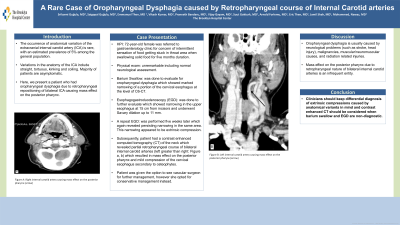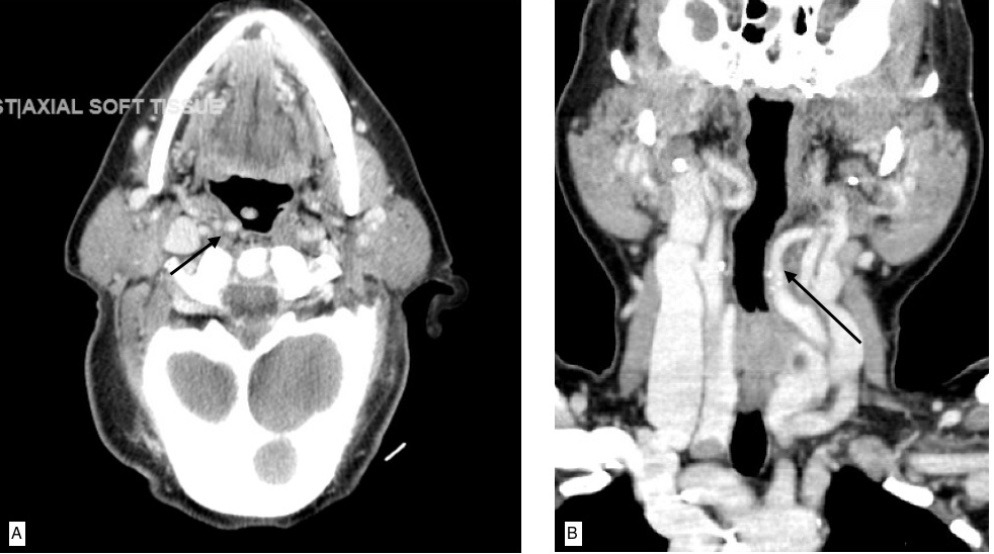Monday Poster Session
Category: Esophagus
P1886 - A Rare Case of Oropharyngeal Dysphagia Caused by Retropharyngeal Course of Internal Carotid Arteries
Monday, October 23, 2023
10:30 AM - 4:15 PM PT
Location: Exhibit Hall

Has Audio
- SG
Srilaxmi Gujjula, MD
Brooklyn Hospital Center
Brooklyn, New York
Presenting Author(s)
Srilaxmi Gujjula, MD1, Saigopal R. Gujjula, 2, Enmanuel Then, 3, Vikash Kumar, MD1, Praneeth Bandaru, MD1, Vijay Gayam, MD1, Suut Gokturk, MD4, Arnold Forlemu, MD, MPH1, Eric Then, MD1, Jamil Shah, MD1, Mohammad Nawaz, MD1
1Brooklyn Hospital Center, Brooklyn, NY; 2American University of Antigua, Coolidge, Saint John, Antigua and Barbuda; 3Universidad Iberoamericana, Gazcue, Distrito Nacional, Dominican Republic; 4SBH, Cheshire, CT
Introduction: The occurrence of anatomical variation of the extracranial internal carotid artery (ICA) is rare, with an estimated prevalence of 5% among the general population. Variations in the anatomy of the ICA include straight, tortuous, kinking and coiling. Majority of patients are asymptomatic. Here, we present a patient who had oropharyngeal dysphagia due to retropharyngeal positioning of bilateral ICA causing mass effect on the posterior pharynx.
Case Description/Methods: 72-year-old female was referred to gastroenterology clinic for concern of intermittent sensation of food getting stuck in throat area when swallowing solid food for five months duration. Physical exam was unremarkable including normal neurological assessment. Barium Swallow was done to evaluate for oropharyngeal dysphagia which showed marked narrowing of a portion of the cervical esophagus at the level of C6-C7. An esophagogastroduodenoscopy (EGD) was done to further evaluate which showed narrowing in the upper esophagus at 15 cm from incisors and underwent Savary dilation up to 11 mm. A repeat EGD was performed five weeks later which again revealed persisting narrowing in the same area. This narrowing appeared to be caused by extrinsic compression. Subsequently, patient had a contrast enhanced computed tomography (CT) of the neck which revealed partial retropharyngeal course of bilateral internal carotid arteries which resulted in mass effect on the posterior pharynx (Figure A: right ICA (arrow), Figure B: left ICA (arrow)) and mild compression of the cervical esophagus secondary to osteophytes. Patient was given the option to see vascular surgeon for further management, however she opted for conservative management instead.
Discussion: Oropharyngeal dysphagia is usually caused by neurological problems (such as stroke, head injury), malignancies, muscular/neuromuscular causes, and radiation related injuries. Mass effect on the posterior pharynx due to retropharyngeal nature of bilateral internal carotid arteries is an infrequent entity. Clinicians should keep differential diagnosis of extrinsic compressions caused by anatomical variants in mind and contrast enhanced CT should be considered when barium swallow and EGD are non-diagnostic.

Disclosures:
Srilaxmi Gujjula, MD1, Saigopal R. Gujjula, 2, Enmanuel Then, 3, Vikash Kumar, MD1, Praneeth Bandaru, MD1, Vijay Gayam, MD1, Suut Gokturk, MD4, Arnold Forlemu, MD, MPH1, Eric Then, MD1, Jamil Shah, MD1, Mohammad Nawaz, MD1. P1886 - A Rare Case of Oropharyngeal Dysphagia Caused by Retropharyngeal Course of Internal Carotid Arteries, ACG 2023 Annual Scientific Meeting Abstracts. Vancouver, BC, Canada: American College of Gastroenterology.
1Brooklyn Hospital Center, Brooklyn, NY; 2American University of Antigua, Coolidge, Saint John, Antigua and Barbuda; 3Universidad Iberoamericana, Gazcue, Distrito Nacional, Dominican Republic; 4SBH, Cheshire, CT
Introduction: The occurrence of anatomical variation of the extracranial internal carotid artery (ICA) is rare, with an estimated prevalence of 5% among the general population. Variations in the anatomy of the ICA include straight, tortuous, kinking and coiling. Majority of patients are asymptomatic. Here, we present a patient who had oropharyngeal dysphagia due to retropharyngeal positioning of bilateral ICA causing mass effect on the posterior pharynx.
Case Description/Methods: 72-year-old female was referred to gastroenterology clinic for concern of intermittent sensation of food getting stuck in throat area when swallowing solid food for five months duration. Physical exam was unremarkable including normal neurological assessment. Barium Swallow was done to evaluate for oropharyngeal dysphagia which showed marked narrowing of a portion of the cervical esophagus at the level of C6-C7. An esophagogastroduodenoscopy (EGD) was done to further evaluate which showed narrowing in the upper esophagus at 15 cm from incisors and underwent Savary dilation up to 11 mm. A repeat EGD was performed five weeks later which again revealed persisting narrowing in the same area. This narrowing appeared to be caused by extrinsic compression. Subsequently, patient had a contrast enhanced computed tomography (CT) of the neck which revealed partial retropharyngeal course of bilateral internal carotid arteries which resulted in mass effect on the posterior pharynx (Figure A: right ICA (arrow), Figure B: left ICA (arrow)) and mild compression of the cervical esophagus secondary to osteophytes. Patient was given the option to see vascular surgeon for further management, however she opted for conservative management instead.
Discussion: Oropharyngeal dysphagia is usually caused by neurological problems (such as stroke, head injury), malignancies, muscular/neuromuscular causes, and radiation related injuries. Mass effect on the posterior pharynx due to retropharyngeal nature of bilateral internal carotid arteries is an infrequent entity. Clinicians should keep differential diagnosis of extrinsic compressions caused by anatomical variants in mind and contrast enhanced CT should be considered when barium swallow and EGD are non-diagnostic.

Figure: Figure A: Right internal carotid artery causing mass effect on the posterior pharynx (arrow)
Figure B: Left internal carotid artery causing mass effect on the posterior pharynx (arrow)
Figure B: Left internal carotid artery causing mass effect on the posterior pharynx (arrow)
Disclosures:
Srilaxmi Gujjula indicated no relevant financial relationships.
Saigopal Gujjula indicated no relevant financial relationships.
Enmanuel Then indicated no relevant financial relationships.
Vikash Kumar indicated no relevant financial relationships.
Praneeth Bandaru indicated no relevant financial relationships.
Vijay Gayam indicated no relevant financial relationships.
Suut Gokturk indicated no relevant financial relationships.
Arnold Forlemu indicated no relevant financial relationships.
Eric Then indicated no relevant financial relationships.
Jamil Shah indicated no relevant financial relationships.
Mohammad Nawaz indicated no relevant financial relationships.
Srilaxmi Gujjula, MD1, Saigopal R. Gujjula, 2, Enmanuel Then, 3, Vikash Kumar, MD1, Praneeth Bandaru, MD1, Vijay Gayam, MD1, Suut Gokturk, MD4, Arnold Forlemu, MD, MPH1, Eric Then, MD1, Jamil Shah, MD1, Mohammad Nawaz, MD1. P1886 - A Rare Case of Oropharyngeal Dysphagia Caused by Retropharyngeal Course of Internal Carotid Arteries, ACG 2023 Annual Scientific Meeting Abstracts. Vancouver, BC, Canada: American College of Gastroenterology.
